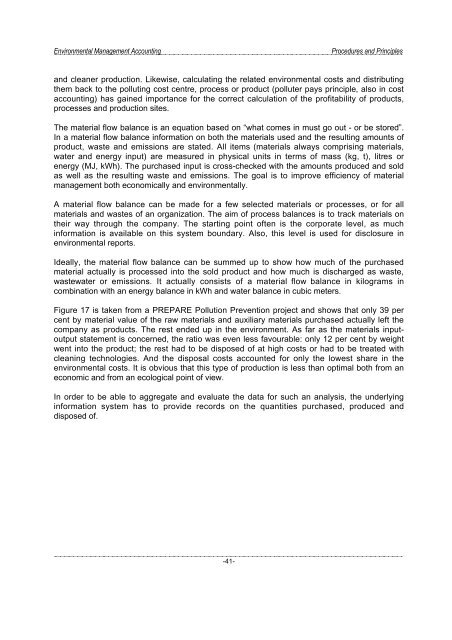Environmental Management Accounting Procedures and Principles
Environmental Management Accounting Procedures and Principles
Environmental Management Accounting Procedures and Principles
Create successful ePaper yourself
Turn your PDF publications into a flip-book with our unique Google optimized e-Paper software.
<strong>Environmental</strong> <strong>Management</strong> <strong>Accounting</strong><br />
<strong>Procedures</strong> <strong>and</strong> <strong>Principles</strong><br />
<strong>and</strong> cleaner production. Likewise, calculating the related environmental costs <strong>and</strong> distributing<br />
them back to the polluting cost centre, process or product (polluter pays principle, also in cost<br />
accounting) has gained importance for the correct calculation of the profitability of products,<br />
processes <strong>and</strong> production sites.<br />
The material flow balance is an equation based on “what comes in must go out - or be stored”.<br />
In a material flow balance information on both the materials used <strong>and</strong> the resulting amounts of<br />
product, waste <strong>and</strong> emissions are stated. All items (materials always comprising materials,<br />
water <strong>and</strong> energy input) are measured in physical units in terms of mass (kg, t), litres or<br />
energy (MJ, kWh). The purchased input is cross-checked with the amounts produced <strong>and</strong> sold<br />
as well as the resulting waste <strong>and</strong> emissions. The goal is to improve efficiency of material<br />
management both economically <strong>and</strong> environmentally.<br />
A material flow balance can be made for a few selected materials or processes, or for all<br />
materials <strong>and</strong> wastes of an organization. The aim of process balances is to track materials on<br />
their way through the company. The starting point often is the corporate level, as much<br />
information is available on this system boundary. Also, this level is used for disclosure in<br />
environmental reports.<br />
Ideally, the material flow balance can be summed up to show how much of the purchased<br />
material actually is processed into the sold product <strong>and</strong> how much is discharged as waste,<br />
wastewater or emissions. It actually consists of a material flow balance in kilograms in<br />
combination with an energy balance in kWh <strong>and</strong> water balance in cubic meters.<br />
Figure 17 is taken from a PREPARE Pollution Prevention project <strong>and</strong> shows that only 39 per<br />
cent by material value of the raw materials <strong>and</strong> auxiliary materials purchased actually left the<br />
company as products. The rest ended up in the environment. As far as the materials inputoutput<br />
statement is concerned, the ratio was even less favourable: only 12 per cent by weight<br />
went into the product; the rest had to be disposed of at high costs or had to be treated with<br />
cleaning technologies. And the disposal costs accounted for only the lowest share in the<br />
environmental costs. It is obvious that this type of production is less than optimal both from an<br />
economic <strong>and</strong> from an ecological point of view.<br />
In order to be able to aggregate <strong>and</strong> evaluate the data for such an analysis, the underlying<br />
information system has to provide records on the quantities purchased, produced <strong>and</strong><br />
disposed of.<br />
-41-




